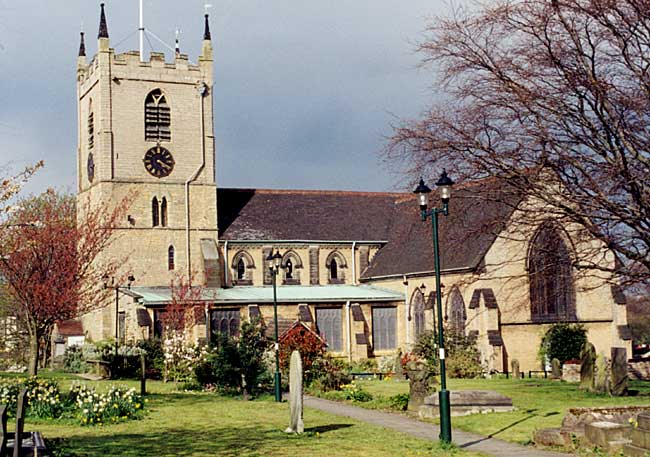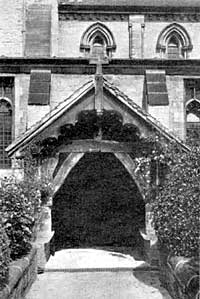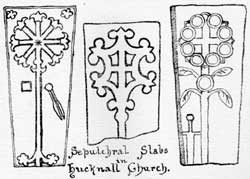Hucknall Torkard parish church
By MR. J. H. BEARDSMORE.

St. Mary Magdalene’s church in 2002.
The parish church at Hucknall Torkard is built upon the gentle eminence whereon the “Oakenhall” stood, from which the parish derived its forename.
The oldest part of the present church dates from 1180, and consists of the three lower storeys of the tower. The probable founder of the fabric was Geoffrey Torcard, who flourished in the latter half of the 12th century, and was a generous son of the Church, as his benefactions to Lenton Abbey indicate.
The church at Hucknall was originally dedicated in the names of St. Mary Magdalene and All Saints, as appears from the will of John de Sutton, dated 1433. It was singular that in the latter part of the 19th century, it was not known at Hucknall to whom the church was dedicated, but as the village feast occurred near St. James’ day, in July, it was assumed that St. James was the patron saint, and several objects in the parish were thus named. The Rev. J. B. Phillips (vicar 1875-1904) discovered from an old map that it was St. Mary Magdalene’s church, and this is the name it bears to-day.
The original foundation consisted of a heavy, stunted tower and small nave. Entrance was effected through a door on the western face, now converted into a window. A Transitional arch of good proportions opened into the nave, and this feature is preserved to-day, but the whole of the first nave has gone.
 Porch at Hucknall Church.
Porch at Hucknall Church.An enlargement was made about the year 1320 by the addition of a chancel, porch, belfry, and a north aisle, the latter terminating eastwards with a chapel. The barge-board of the porch remains to-day, severely weathered, but of sound Sherwood oak. The font is fashioned heavily, hexagonal in shape, very plain in appearance, and dates from the 14th century. Thomas Torcard was vicar AD. 1297-1324, and probably had much to do with the improvement of the fabric at that period.
About the year 1475, Perpendicular lights replaced the Decorated lights in the north aisle, and at some period in the middle ages, the same wall appears to have been pierced by two “lowsided windows,” at a spot where a view of the altar could be obtained.
The 18th century work was of a debased character. The open benches were replaced by the horsebox pews; the tower arch was bricked up, and a gallery was erected at the west end. A three-decker pulpit was placed on the south nave wall, and ugly square-headed windows were placed in the same wall. Lead replaced the oolite stone tiles on the roof of nave and aisle; the ceiling was plastered, walls whitewashed, and the lower part of the tower externally stuccoed.
In 1871-2, the influx of a colliery population demanded increased church room. A south aisle was added, gallery demolished, the whole church re-pewed, the fine tower arch re-opened, the new roofs of open timber-work were tiled, an oaken screen was erected between nave and chancel, and an oaken reredos placed in the chancel. This good work owed its inception to Mr. John Godber, who lived some years in the parish, and was substantially helped by the late Duke of Portland, patron of the living.
The final enlargement occurred in 1887-8. The main feature of this alteration was the removal of the chancel twenty-four feet eastward, the gap being filled by transepta, care being taken to reconstruct the chancel in its former state by numbering the stones. The nave roof was lifted and a clerestory added. The effect of this work internally was excellent, but externally the congeries of high roofs dwarfed the tower.
In Thoroton’s time the windows contained heraldic shields of families who held land in successive centuries, but none now remain save a mutilated fragment carefully preserved by the present vicar, the Rev. T. G. Barber.
The late Canon Godber, on inheriting considerable property in the parish, placed within the church a wealth of stained glass and mural decoration, which evokes expressions of admiration from Byronic pilgrims from many climes, and has, naturally, tended to create a pardonable pride among the parishioners of their parish church. The stained glass is by Kempe.
There are three bells in the tower. The oldest, a treble, has evidently been used in some abbey, presumably Newstead. It bears the inscription “Ave Maria.” The tenor bell was founded by Oldfield, in Nottingham, A.D. 1639, and carries the prayer “God save the Church.” The bass bell was from Thomas Hedderley’s Nottingham foundry, and is dated 1749.
The porch door is of oak, massive and strong, and bears traces of having been fashioned with axe and adze. It was formerly fastened from the inside by a wooden bar pushed into a hole in the jamb, and an iron slot.
The registers date from 1559.

Three sepulchral slabs were found in the south nave and chancel walls in the 19th century enlargements, all mutilated, as shown on the accompanying engraving.
Several other fragments of stone coffin lids, bearing parts of incised crosses, may be discerned at the backs of the sedilia and the piscina of the north-east chapel. The three shown on the engraving are now fully exposed to view on the church walls.
